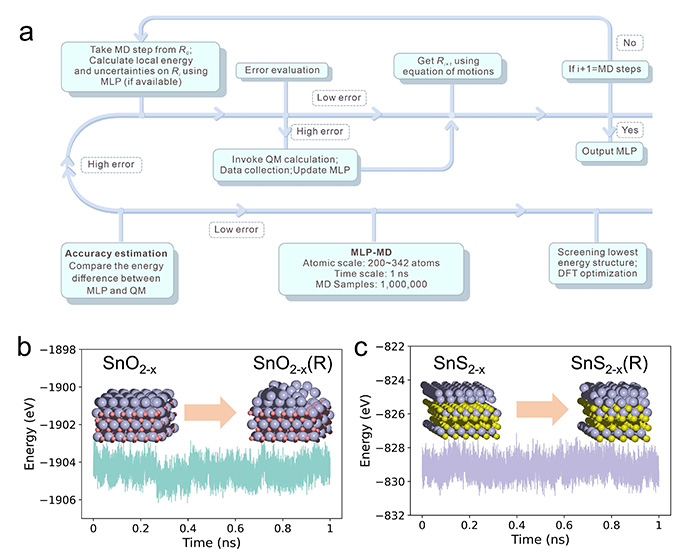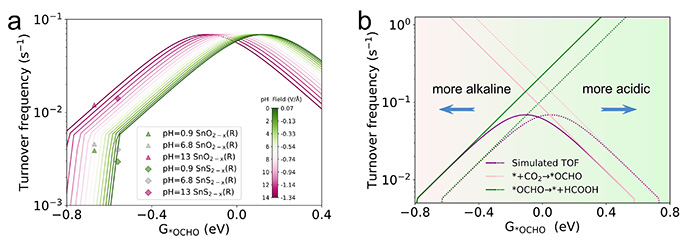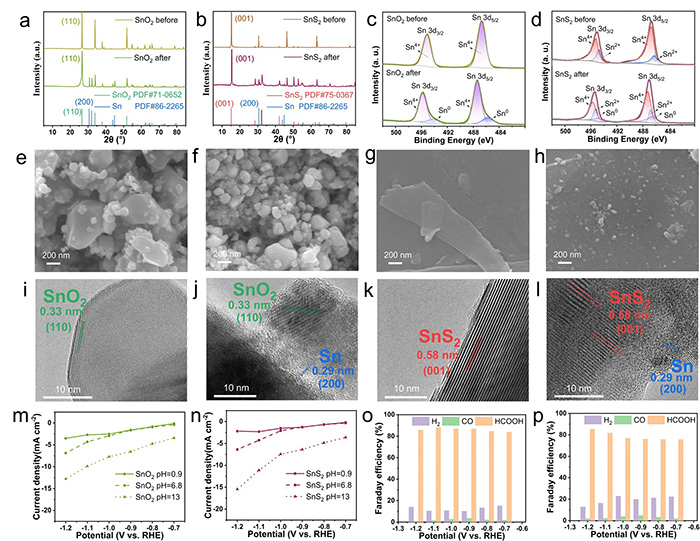

Some of the most encouraging results for reaction-enhancing catalysts come from one material in particular: tin (Sn). While Sn’s overall utility as a catalyst is well-known, its underlying structure-performance relationship is poorly understood, which limits our ability to maximize its potential. To address this knowledge gap, researchers at Tohoku University’s Advanced Institute for Materials Research (WPI-AIMR) used machine learning to characterize Sn catalyst activity. The highly accurate simulations could be a game-changer that helps researchers swiftly and simply design high-performance complex catalysts.
“The reason these catalysts are so important is that they can convert harmful carbon dioxide – CO2 – into carbon-based fuels using renewable electricity, offering a sustainable solution to energy shortages and climate change,” explains Hao Li of WPI-AIMR. “The aim of this research is to guide our society towards carbon neutrality.”

Machine learning potential (MLP) training for surface reconstruction analyses. (a) Workflow for MLP training and large-scale configuration space searching. (b-c) Molecular dynamics (MD) simulations at the nanosecond scale and mesoscopic size for (b) SnO2-x and (c) SnS2-x. Insets show the possible structures with the lowest energy surface screened out by large-scale sampling. Light grey, red, and yellow spheres represent Sn, O, and S, respectively. ©Hao Li et al.
To closely examine Sn catalysts, they employed machine learning potential to perform large-scale molecular dynamics simulations, successfully capturing the reconstructed configurations of SnO2/SnS2. The approach used data from over 1,000 experimental literature sources to identify various Sn-based catalysts.
“Instead of spending days, months, or even years doing all of these experiments in the lab, we can run these sophisticated, data-driven simulations that can helpfully inform which lab-based experiments to focus our attention on,” says Li.

pH-dependent microkinetic modelling at the RHE-scale. (a) pH-dependent microkinetic modelling for CO2RR on Sn-based catalysts. Lower electric fields correspond to more alkaline conditions, whereas higher fields indicate more acidic conditions. (b) Rate-determining step analysis for HCOOH formation at acidic (dashed lines) and alkaline (solid lines) conditions. The purple lines indicate activity limited by the 1st electron transfer, while the green lines demonstrate limitations due to the 2nd electron transfer. ©Hao Li et al.
The catalysts identified by the model were run in simulations that monitored their activity at different pH levels at the reversible hydrogen electrode (RHE) scale. The researchers examined the CO2 reduction reaction, to see how each catalyst performed under different conditions. Calculations from previous literature struggled to accurately account for the impact of pH-dependence on electrocatalytic performance, therefore these results provide novel insights into the behaviour of these catalysts.
Furthermore, the simulation results show excellent agreement with actual experimental observations, which validates the accuracy of this machine learning technique. This study helps us form a more comprehensive understanding of Sn-based catalysts, so that their full potential can be brought out. More efficient catalysts bring affordable green fuel production closer to being an everyday reality.
In the future, the research group plans to optimize the training process of the machine learning potential to develop a more accurate and universal training framework, thereby better bridging the gap between experimental findings and theoretical predictions.
All relevant experimental and computational data have been uploaded to the Digital Catalysis Platform (DigCat) , the largest catalysis database and digital platform developed by the Hao Li lab.
, the largest catalysis database and digital platform developed by the Hao Li lab.
The findings were published in Advanced Functional Materials on June 26, 2025.

Materials characterizations and performance tests. (a-b) XRD spectra of SnO2 and SnS2 before and after CO2RR. (c-d) XPS spectra of SnO2 and SnS2 before and after the reaction. (e-f) SEM images for SnO2: (e) before and (f) after the reaction. (g-h) SEM images for SnS2: (g) before and (h) after the reaction. (i-j) HRTEM images for SnO2: before (i) and (j) after the reaction. (k-l) HRTEM images for SnS2: (k) before and (l) after the reaction. (m-n) The current densities vs. applied potentials of SnO2 and SnS2 at different pH levels. (o-p) Faradaic efficiencies of CO2RR on SnO2 and SnS2 at different potentials under pH = 13. ©Hao Li et al.
| タイトル: | Bridging Theory and Experiment: Machine Learning Potential-Driven Insights into pH-Dependent CO2 Reduction on Sn-Based Catalysts |
|---|---|
| 著者: | Yuhang Wang, Zelin Wu, Yingfang Jiang, Di Zhang, Qiang Wang, Congwei Wang, Huihui Li, Xue Jia, Jun Fan, and Hao Li |
| 掲載誌: | Advanced Functional Materials |
| DOI: | 10.1002/adfm.202506314 |
東北大学材料科学高等研究所(WPI-AIMR)
教授 Hao Li(研究者プロフィール)
| E-mail: | li.hao.b8@tohoku.ac.jp |
|---|---|
| Webstie: | Hao Li Laboratory |
東北大学材料科学高等研究所(WPI-AIMR) 広報戦略室
| Tel: | 022-217-6146 |
|---|---|
| E-mail: | aimr-outreach@grp.tohoku.ac.jp |